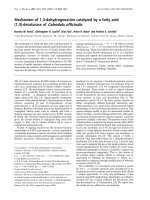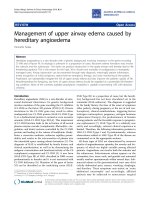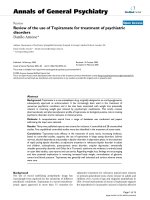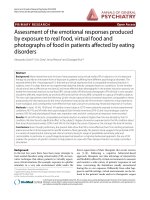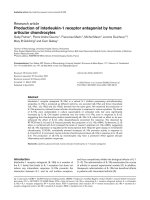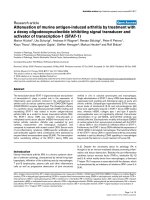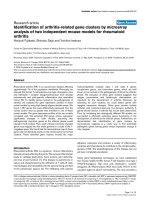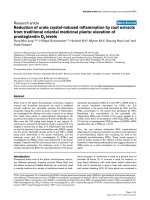Báo cáo y học: "Review of ”Bioinformatics for vaccinology“ edited by Darren R. Flower" pps
Bạn đang xem bản rút gọn của tài liệu. Xem và tải ngay bản đầy đủ của tài liệu tại đây (166.59 KB, 2 trang )
BioMed Central
Page 1 of 2
(page number not for citation purposes)
Virology Journal
Open Access
Book report
Review of ”Bioinformatics for vaccinology“ edited by Darren R.
Flower
Dae-Won Kim and Hong-Seog Park*
Address: Genome Research Center, Korea Research Institute of Bioscience and Biotechnology, Daejeon 305-806, Korea
Email: Dae-Won Kim - ; Hong-Seog Park* -
* Corresponding author
Abstract
Book review of "Bioinformatics for vaccinology" edited by Darren R. Flower.
Book details
Flower DR: Bioinformatics for vaccinology Wiley-Backwell;
2008:292. ISBN 978-0-470-02711-0
Book review
The study of vaccines has captured the attention of the
biomedical and public communities for the past hundred
years, largely because vaccines play a key role in affecting
lifespan and well being, as well as economics. A positive
trend in the field of vaccinology has been inspired by
recent major breakthroughs in the fields of molecular
biology, physiology, genomics, proteomics, and comput-
ers that promise a bright future for the prevention of infec-
tious diseases and allergies. This book focuses on a
fundamental understanding of the primary role of vac-
cines from a historical perspective, the immune system in
molecular cell biology and computational approaches
that show the link between experiment and theory.
The major portion of the book is divided into seven chap-
ters. Chapter one provides a historical background of vac-
cination that acts as a framework for the remainder of the
book. Overall, this chapter provides a comprehensive
overview of several interesting subjects based on effective
and efficient efforts at developing vaccines. Chapter two
focuses on the introductory need and opportunity for vac-
cines, followed by the role of unprecedented phenome-
non, such as rapid changes in economic status, climate
and infectious disease. Chapter three describes how a rig-
orous biological perspective of the molecular immune
system is a fundamental requirement for the development
of computational algorithms to explain how vaccines
work. It further provides a discussion of how informatics
approaches can give a glimpse of vaccine discovery. Chap-
ter four contains an introduction into '-omics' and reviews
the most important biological sequence databases, such
as the host databases, immunological databases, patho-
gen databases, and T cell and B cell databases. Chapter five
describes the computational challenges in predicting T
cell and B cell epitopes and in allergen discovery. Moreo-
ver, it provides a description of computational algo-
rithms, including artificial neural networks (ANN),
hidden Markov models (HMM), support vector machines
(SVM), and introduces statistical models to assess predic-
tion accuracy. Chapter six presents protein structural
approaches for experimental screening using 3D-QSAR or
for virtual screening (VS). Chapter seven addresses the
importance and potential of computational vaccinology
in the post-genomic era.
This book has several strong points. Although there are
many textbooks that deal with vaccinology, few attempts
have been made to bring together descriptions of vaccines
in history, basic bioinformatics, various computational
solutions and challenges in vaccinology, detailed experi-
mental methodologies, and cutting-edge technologies.
Published: 24 June 2009
Virology Journal 2009, 6:85 doi:10.1186/1743-422X-6-85
Received: 10 June 2009
Accepted: 24 June 2009
This article is available from: />© 2009 Kim and Park; licensee BioMed Central Ltd.
This is an Open Access article distributed under the terms of the Creative Commons Attribution License ( />),
which permits unrestricted use, distribution, and reproduction in any medium, provided the original work is properly cited.
Publish with BioMed Central and every
scientist can read your work free of charge
"BioMed Central will be the most significant development for
disseminating the results of biomedical research in our lifetime."
Sir Paul Nurse, Cancer Research UK
Your research papers will be:
available free of charge to the entire biomedical community
peer reviewed and published immediately upon acceptance
cited in PubMed and archived on PubMed Central
yours — you keep the copyright
Submit your manuscript here:
/>BioMedcentral
Virology Journal 2009, 6:85 />Page 2 of 2
(page number not for citation purposes)
The book is aimed at researchers with a working knowl-
edge of disease, the nature of vaccines, computational
approaches and system biology. The lesser focus on basic
concepts and theories may make this book undesirable as
a textbook for beginners or undergraduate students in vac-
cinology. However, the book contains a large amount of
information on computation and experimental tech-
niques that would be highly useful in the study of vaccines
and in the pharmaceutical industry or for researchers who
intend to prepare and use vaccines in their research. This
book may well serve as a first line of reference for all biol-
ogists and computer scientists.
One of the major goals of the incorporation of bioinfor-
matics into vaccinology is to aid in the design of vaccines
and to apply informatics approaches to the development
of novel therapeutics and vaccine candidates. This book
provides details of basic vaccinology and its application,
beginning with a consideration of computational
approaches. This presentation should provide readers of
this book the opportunity to absorb the information
about the biological immune system, the mathematical
methods and the immunoinformatics. Overall, this text-
book would be an excellent addition to the bookshelf of
most scientists who encounter vaccinology in the drug
discovery and development processes.
Competing interests
The authors declare that they have no competing interests.
Authors' contributions
DK: conception, drafting and final approval of the manu-
script. HP: drafting and final approval of the manuscript.

